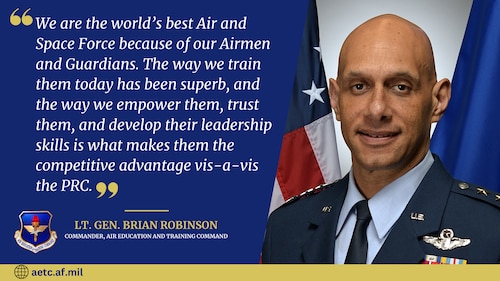Lt. Gen. Brian S. Robinson, commander of Air Education and Training Command, shared his perspective on how the command is building an expanded, people-focused footprint in support of the service's efforts to reoptimize for Great Power Competition during an Air and Space Forces Association's 2024 Air, Space and Cyber Conference panel at National Harbor, Sept. 17.
Robinson joined other senior leaders from across the Department of the Air Force on the main stage for the "Standing Up the New Commands" panel to explain to the force new initiatives that will be realized under the soon-to-be redesignated Airman Development Command and share why a "Mission Over Function" mindset matters when it comes to force development.
"We train with the functional authorities we have now," Robinson said. "But we train set requirements and deliver educational experiences and development along those functional boundaries without anybody looking across the aggregation of what the mission environment requires of us to employ an operational force that is successful in the battlespace we see. Making this change to achieve a 'mission over function' perspective, we need a command that is organized in a way to see across functional boundaries, informed by functional authorities about what they know they need from a policy perspective, a strategy perspective, a resourcing perspective, and end strength. The changes we are making here will help deliver Airmen and Guardians out to the force who are ready to go."
Providing a competency-based approach to training to give Airmen and Guardians the agility, skills, capability and confidence to operate in an uncertain and ambiguous environment is critical to mission success in Great Power Competition.
"The future force design has to adapt to the future operating concept and the battlespace concept we see now," Robinson said. "We also have to give our Airmen and Guardians the right set of competencies and skills to prosecute that fight."
Robinson also noted how the command is making changes with the mindset of being the service's institutional command charged with ensuring force development is done through a mission-ready lens.
"Right now, from recruiting, accessions, initial skills training, and leadership development, AETC is charged with producing Airmen who have the functional competencies needed to enter the operational force," Robinson said. "Our charge is to get those skills and competencies ingrained in our people in an integrated fashion with the entire mission set in mind as early as possible using the best technologies, techniques and human-centered learning as we can.
In answering a question about how ADC will integrate with the new Integrated Capabilities Command (Provisional), the general highlighted the role the new technical and flying training Centers of Excellence will play.
"We need liaison officers from our COEs to sit down with those teams and listen to how that capability that is being envisioned will be employed to think through two things ADC will have in its portfolio," Robinson said. "One, we need to start to draft doctrine. Secondly, how will we train to that? Start to develop curriculum and how we train and teach Airmen in initial skills training so we can do that in a parallel manner further to the left in the process."
Industry will also be a key component of transition, with the new ADC standing up a 25-person Enterprise Learning Engineering Center focused on looking broadly across industry to look at new technologies, learning engineering and methodologies to figure out how we can best develop Airmen.
"A lot of this will be human performance," Robinson said. "Really what types of cognition tools and methods allow us to accelerate learning so Airmen grasp skills more quickly and are ready to go."
To illustrate a point about how the consolidation of career field management responsibilities under an expanded ADC would bring more rapid agility to curriculum development, Robinson shared the example of the security forces career field's new "Defender Next" construct.
"We made that change in nine months where other areas have taken two, three, sometimes five years to make changes to training curriculum," Robinson said. "To quote (AETC command chief master sergeant) Chief Master Sgt. Chad Bickley, the People's Republic of China builds islands in the South China Sea in less time than that. That's why this is important."
As for the timeline of the redesignation to ADC, Robinson stated the command is working aggressively towards a full operational capability date of Oct. 1, 2025.
"We are on the timeline our Chief of Staff, Gen. (David) Allvin needs us to be on. When he gives us the cue to designate the organizational name change, we will be ready," Robinson said.
At the end of the day, Airmen and Guardians remain the deciding factor against any adversary.
"We are the world's best air and space force because of our Airmen and Guardians," Robinson said. "The way we train them today has been superb, and the way we empower them, trust them and develop their leadership skills is what makes them the competitive advantage vis-a-vis the PRC."







